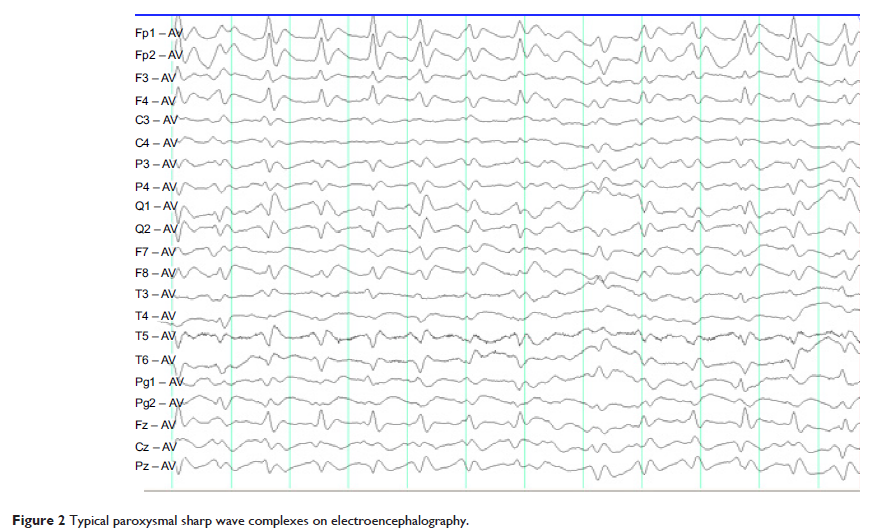9 7 6 4 1
论文已发表
注册即可获取德孚的最新动态
IF 收录期刊
- 3.3 Breast Cancer (Dove Med Press)
- 3.4 Clin Epidemiol
- 2.5 Cancer Manag Res
- 2.9 Infect Drug Resist
- 3.5 Clin Interv Aging
- 4.7 Drug Des Dev Ther
- 2.7 Int J Chronic Obstr
- 6.6 Int J Nanomed
- 2.5 Int J Women's Health
- 2.5 Neuropsych Dis Treat
- 2.7 OncoTargets Ther
- 2.0 Patient Prefer Adher
- 2.3 Ther Clin Risk Manag
- 2.5 J Pain Res
- 2.8 Diabet Metab Synd Ob
- 2.8 Psychol Res Behav Ma
- 3.0 Nat Sci Sleep
- 1.8 Pharmgenomics Pers Med
- 2.7 Risk Manag Healthc Policy
- 4.2 J Inflamm Res
- 2.1 Int J Gen Med
- 4.2 J Hepatocell Carcinoma
- 3.7 J Asthma Allergy
- 1.9 Clin Cosmet Investig Dermatol
- 2.7 J Multidiscip Healthc

已发表论文
有进行性认知功能障碍者在分别患有克雅二氏病 (Creutzfeldt-Jakob disease) 与抗 LGI1 抗体相关边缘叶脑炎的情况下的精神症状、不自主脸部-腕足-脚部运动和异常脑电图: 病例报告
Authors Sun L, Cao J, Liu C, Lv Y
Published Date June 2015 Volume 2015:11 Pages 1427—1430
DOI http://dx.doi.org/10.2147/NDT.S81414
Received 23 January 2015, Accepted 19 March 2015, Published 11 June 2015
Approved for publication by Professor Wai Kwong Tang
Abstract: Diagnosis of Creutzfeldt-Jakob disease (CJD) is often challenging in elderly individuals, not only because of its variable clinical features but also because of nonspecific changes on the electroencephalogram (EEG) in the early stages of the disease. Here we report on a patient who presented with progressive cognitive dysfunction, psychiatric symptoms, involuntary facio-brachio-crural movement, and an abnormal EEG. We provide a detailed analysis and differential diagnosis between anti-leucine-rich glioma inactivated 1 (LGI1) limbic encephalitis versus CJD, in the hope of providing a new understanding of CJD. A 65-year-old Chinese man presented with slowly progressive cognitive decline with psychiatric symptoms. On admission, he presented with facial grimacing and brief left upper limb dystonic posturing lasting 1–2 seconds, with hyponatremia that was difficult to rectify. Neurological examination showed increased muscle tension in the left limb but without pathological reflexes. His early EEG showed focal periodic wave complexes. Diffusion-weighted magnetic resonance imaging showed a suspected “lace sign” in the occipital cortex. His cerebrospinal fluid was negative for LGI1 antibodies and positive for 14-3-3 brain protein. Therefore, we made a presumptive diagnosis of CJD. At the following visit, a second EEG showed paroxysmal sharp wave complexes, but the patient had a poor prognosis. Atypical facio-brachio-crural movement and nonspecific EEG changes may occasionally be found in patients with CJD or anti-LGI1 encephalitis. Clinicians should not be dissuaded from a diagnosis of CJD where the EEG does not show paroxysmal sharp wave complexes in the early stages but abnormal facio-brachio-crural movement is present.
Keywords: abnormal facio-brachio-crural movement, hyponatremia, Creutzfeldt-Jakob disease, leucine-rich glioma inactivated 1, paroxysmal sharp wave complexes
Keywords: abnormal facio-brachio-crural movement, hyponatremia, Creutzfeldt-Jakob disease, leucine-rich glioma inactivated 1, paroxysmal sharp wave complexes
